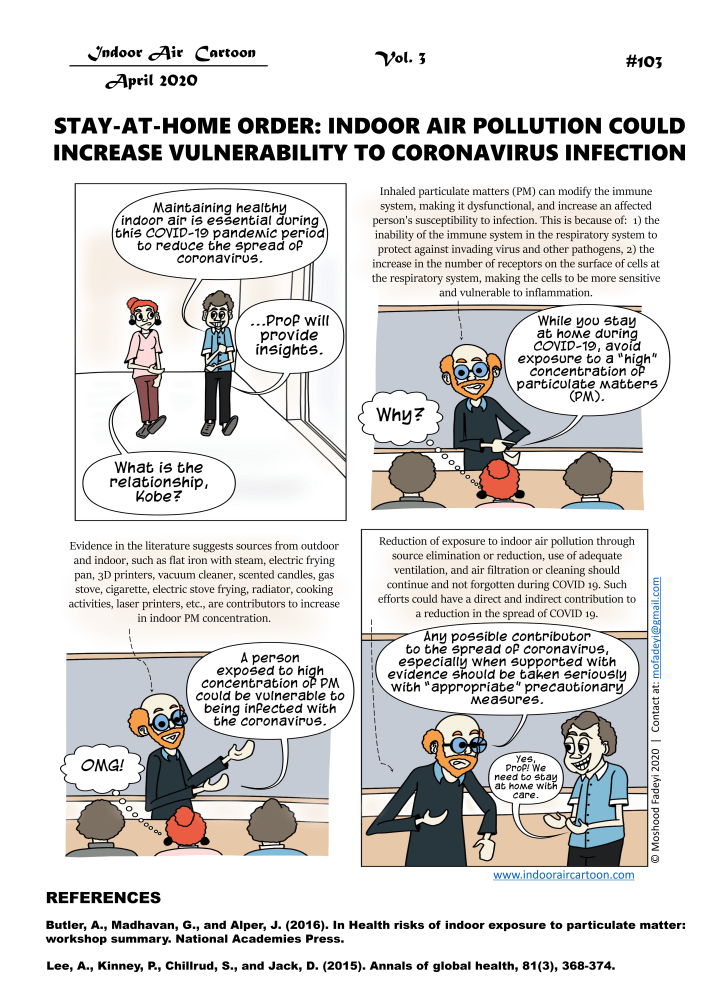Indoor Air Cartoon Journal, April 2020, Volume 3, #103

Stay at home! This is an order or recommendation from the government in many countries. It is generally believed that staying at home measures would help reduce exposure to coronavirus – SARS-CoV-2. A significant number of people could be exposed to the virus if the order is not in place or effectively implemented. So, what happens when we stay at home?
The intensity and frequency of activities at home increase. Building occupants’ activities are potential contributors of pollutants in the indoor environment. Thus, if human activities increase, the tendency of generating a high concentration of air pollutants will be higher, especially if the occupants are not conscious of how their activities are or could be contributing to indoor air pollution.
An example of indoor air pollutants commonly generated from human activities in the indoor environment is particulate matter (PM). Evidence in the literature suggests indoor sources may include flat iron with steam, electric frying pan, 3D printers, vacuum cleaner, sweeping of floor, scented candles, gas stove, cigarette, electric stove frying, radiator, solid fuel burning, cooking activities, laser printers, etc., are contributors to increase in indoor PM concentration. Outdoor to indoor transport is another contributor to indoor PM concentration in an unsustainable world.
Evidence in the literature suggests PM exposure could cause adverse health effects relating to cardiovascular and respiratory diseases or health effects, and if care is not taken, it could lead to death. Our immune system is designed to protect us against such adverse health occurrences. However, toxic particulate matters (PM) attack this human defense mechanism. Inhaled PM can modify the immune system, making it dysfunctional, and increase an affected person’s susceptibility to infection.
This is because of: 1) the inability of the immune system in the respiratory system to protect against invading virus and other pathogens, 2) the increase in the number of receptors on the surface of cells at the respiratory system, making the cells to be more sensitive and vulnerable to inflammation.
At what concentration would PM modify the immune system? I don’t know. However, a reasonable answer would be it is subjective. The word “high” concentration is relative in terms of human dose-effect. It is relative to the physiological condition of the exposed person. Perhaps, it could also be due to the psychological condition. Very little is known on the psychological aspect, though.
Thus, let us focus on the physiological condition aspect. The “cutoff point” of someone with a pre-existing adverse health problem, especially those related to respiratory conditions or weakened immune systems, will be reached relatively faster as compared to a healthy person.
If a person with a compromised immune system, due to PM, is exposed to the virus, the chances of being infected could be much higher than someone with no compromised immune system, under the same virus exposure condition – nature and concentration of the virus. The exposure could be through delivered food, goods, and materials or a member of the family that got infected outside the house, e.g., through outings to get essentials for the family.
An infected person in the house could be a potential spreader, especially if asymptomatic, in the community. Very little is known about the relationship between indoor air pollution, particularly during stay-at-home order, and susceptibility to coronavirus infection.
Nevertheless, it is a possibility based on what is known on how PM exposure could compromise the immune system needed to provide human defense against the coronavirus. Thus, it makes sense to adopt necessary measures to improve indoor air quality.
Reduction of exposure to indoor air pollution, particularly PM, through source elimination or reduction, use of adequate ventilation, and air filtration or cleaning should continue and not forgotten during and after the COVID 19 disease pandemic. Such efforts could have a direct and indirect contribution to a reduction in the spread of COVID 19 disease.
Remember, healthy indoor air is a healthier life. A healthier life is a healthy economy. When you stay at home, make sure you take good care of your indoor air. You also need to be mindful of the dust on surfaces in the indoor environment. Before you go, think about this. How can people in countries with poor economic power or suffering poor public policy afford the mitigation strategies? Would such people be more susceptible?
Do you want to know more about this topic? Read Butler et al. (2016) and Lee et al. (2015) papers.


[…] pollutants can weaken the immune system, i.e., increases physiological vulnerability. For example, a respiratory organ’s weakened immune system caused by particulate matters may make an exposed person susceptible to being infected with the […]